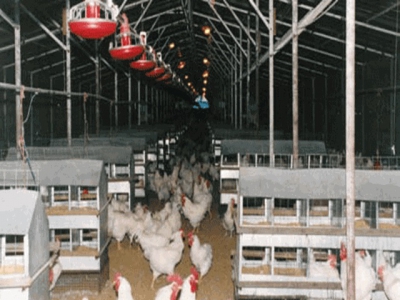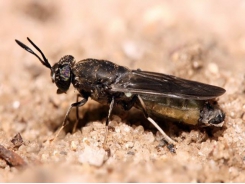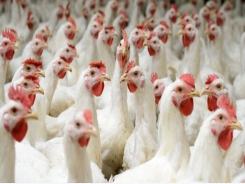Encouraging Hens to Lay in Nests

The occurrence of non-nest eggs (floor and slat eggs) will lead to increased labour requirements, reduced hatching egg quality and a potential reduction in hatch and chick quality. Understanding the reasons why eggs are laid outside the nests and what can be done to minimise them is important if chick output is to be maximised. By Ricardo Valle, Regional Technical Manager of Aviagen in Brazil.
An example of a good manual nest system.
Avoiding or reducing high numbers of non-nest eggs starts with understanding the cause and by examining methods of encouraging hens to lay eggs in the nest. Proper training of hens is vital to get the hens to the nests and to lay there. Training should start during rearing with perches and platforms being provided to train and stimulate the females in jumping and nesting behaviour. Perches should be placed in the rearing pens from 28-42 days of age providing 30cm of perch space per female. Platforms can be used as an alternative or supplement to perches, allowing 1m2 of platform for every 500 females.
Light intensity in rear should be above 10 lux; low light intensities will discourage birds from using the perches and platforms.
Breeder House Preparation
It is important to make sure that all equipment, including the ventilation, feeder and drinker system, is installed and operational before birds enter the house. With facilities that are day-old to depletion all production equipment, especially the nests, must be prepared well before the expected onset of production. Additionally, the house should be prepared in accordance with best practice to ensure maximum comfort and optimum production.
Training Hens
Once the house has been correctly set up, training birds to lay eggs in the nests is the most effective way of preventing non-nest eggs. Nest boxes should be opened just prior to the arrival of the first egg to prevent females losing interest in them and laying eggs elsewhere.
During the laying period, slats and litter areas should be slowly walked a number of times throughout the day by the stockman to look for any pullets that are attempting to establish nest sites out of the nest boxes. Pullets look for nest sites early in the morning so walking the house at this time is advised. Walking in the house 10-12 times during the morning is not too often. Pullets looking for alternative nest sites will be attracted to any dark or shaded areas of the house. Pullets establishing nest sites should be gently picked up and placed in an empty nest. Disturbing the birds should discourage them from using these ‘alternative’ nest sites, but if continued use of these nesting areas.
Non-nest eggs should be gathered frequently because uncollected eggs encourage the laying of more eggs in the same area. The regular and rapid collection of floor eggs is an essential tool for the reduction/elimination of non-nest eggs. With automated systems, the egg gathering belts should be run several times each day - even before obtaining the first egg - so that the pullets are not discouraged from using the nests by the sound and vibration of the equipment.
Feeding and Watering
The timing of feeding should not coincide with the most active laying period. To avoid competition between feeding and laying eggs, birds should be fed within 30 minutes, or not until six hours after, lights on. This is especially important for young pullets that have just been transferred as they will leave the nest to satisfy their appetite, often laying eggs at the feeders. Two daily feeds should be avoided especially after pullets have started to lay eggs. If a second or larger quantity of feed is required, it should be provided before the initial quantity of feed is consumed so that one continuous daily feed is given. occurs, it may be necessary to fence off these areas.
Hens can lay eggs underneath pan feeders that are set at the wrong height or not winched up following feeding, while trough feeders positioned at the incorrect height can become a barrier to the nests. To prevent such problems, feeders should be raised as soon as the feed is consumed. The monitoring of feeding progress and behaviour allows many such potential problems to be identified and resolved.
If a water control programme is employed, water should be made available to the flock at the same time, or slightly before the lights are turned on and throughout the feeding period - in most cases throughout the morning - and should coincide with the most active laying period. Late watering can encourage hens to lay eggs out of the nests as they seek water. Bell drinkers should be at a height that allows all birds to obtain water without providing potential protected nesting sites. Nipple lines minimise this problem but if set too low, it can be a barrier to the nests.
Nest Management
The number of hens per nest is critical for minimising non-nest eggs. No more than 80-90 females per metre should be placed for mechanical nests, and a maximum of 5.5 hens per nest hole for conventional nests. Exceeding these recommendations will increase the incidence of non-nest eggs, especially during the onset of lay and at peak production.
Nests must be maintained with solid bottoms and fresh, clean and dry bedding material. Nest fouling can be discouraged by closing the nests late in the day to prevent birds from roosting in them, and opening them again before the lights come on in the morning.
Automatic nests should be opened 15 minutes before lights are turned on and closed 60 minutes before lights go off. Egg gathering belts should be kept clean throughout the production period and at the very least be cleaned and sanitised between flocks.
Nest units should be securely positioned and should not rock or move when hens enter or leave the unit. Perches need to be kept in a good condition and structurally strong enough to support the weight of several birds at once.
Slat Management
Slat height is critical and with mechanical egg gathering systems should preferably be less than 50cm (20 inches) and no more than 55cm (23 inches) high. Actual slat height will be dependant on the flock’s depletion age and litter height. With higher slats, a ramp should be provided. Where nests are located on the slatted area, nests should be 30-36cm (12-14 inches) from the edge of the slats and the incline from front of the slats to the nest box between five and 10 degrees. The perch height of conventional manual egg gathering systems may be up to 55 cm (22 inches); if lower than this, birds may nest under them. Manual nests should be constructed to eliminate the dark space underneath them either by fencing these areas off or through the provision of additional lighting.
Where automatic nest boxes are used house litter levels should be maintained at 5-8cm (2-3 inches) deep to discourage birds from digging deep comfortable holes in which to lay eggs.
Lighting Management
Darkened areas of the house provide alternative laying areas for birds. It is vital that shadows or poorly lit areas are reduced or eliminated if females are to be encouraged to lay eggs in the nests. Light should be of the correct intensity (light intensity should be uniformly increased from approx. 10-20 lux in the rearing period to 60-100 lux in production) and evenly distributed throughout the house, with additional lighting being supplied where necessary (e.g. under manual nests).
Temperature and Ventilation
House temperature/ventilation will influence the use of nests. Ventilation systems should be adjusted to control temperatures between 18 and 24˚C (65-75˚F). Housing and nest temperatures in excess of, or below, can cause birds to avoid the nests. Proper uniform tunnel ventilated housing with the effective use of evaporative cooling will encourage hens to use nests in warm periods. In the winter it is important to ensure that cold incoming air is not directed into the nests as this will also discourage hens from laying in them. For the same reason fans and fogging systems should not blow forcibly and directly into the nests.
Conclusion
There are no easy answers for reducing the occurrence of floor or slat eggs. A low incidence of floor eggs early in a flock’s life is normally corrected in most cases as the flock get older and hens lay more in the nests. However, flocks with more extreme floor/slat egg problems will continue to be problem flocks throughout the laying period. It is therefore essential that effort is put into preventing the occurrence of floor eggs early on in a life of a flock. The key to achieving this is training, the extra effort of planning, prevention and early training of pullets to lay eggs in the nests. Although not 100%, is the only real means of ensuring a high percentage of nest laid eggs.
Có thể bạn quan tâm
Phần mềm

Phối trộn thức ăn chăn nuôi

Pha dung dịch thủy canh

Định mức cho tôm ăn

Phối trộn phân bón NPK

Xác định tỷ lệ tôm sống

Chuyển đổi đơn vị phân bón

Xác định công suất sục khí

Chuyển đổi đơn vị tôm

Tính diện tích nhà kính

Tính thể tích ao hồ




 How pie pans can help fight poultry diseases
How pie pans can help fight poultry diseases  New rapid method to develop IBV vaccines for…
New rapid method to develop IBV vaccines for…